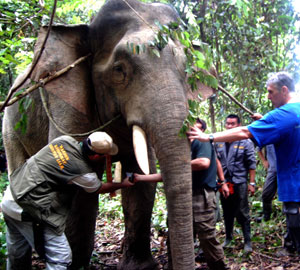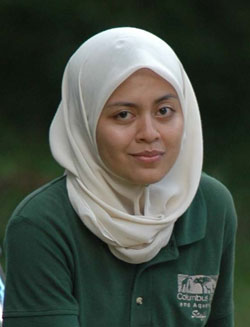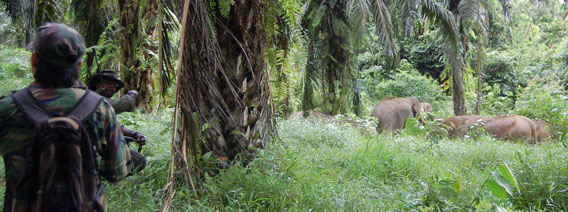Researchers fit Bornean elephants with satellite collars to track social behavior
Researchers fit Bornean elephants with satellite collars to track social behavior
HUTAN
July 14, 2008
|
|
Three Bornean Elephants were fitted with satellite collars over the past week in the Kinabatangan marking the beginning of the first study on their social structure.
“Studies on the genetic aspects of the Bornean Elephant have been carried out in the past but we have yet to study their social structure which is virtually unknown,” said Nurzhafarina Othman, Conservation Biologist at Danau Girang Field Centre (located in the Kinabatangan floodplain) who heads this new study.
“The collaring of the elephants is to ease our access to them. The bulk of the study will be done with actual field work together with the Elephant Conservation Unit (ECU) and we will carry out actual observation and collect DNA information via the faeces of particular individuals,” she added.
The ECU which was founded by French NGO HUTAN in 2002 to address the issue of Human Elephant Conflict will be spending hundreds of man hours tracking these specific elephants for this landmark study.
 Dr. Benoit Goossens of Danau Girang Field Centre fitting the satellite-collar on Gading while Dr. Marc Ancrenaz of HUTAN monitors the elephant. |
“This is a first for us. Instead of just monitoring their movement to ensure against conflict we will be assisting in data collection and this is a good example of capacity building for the team as a whole,” said Sulaiman bin Ismail who heads the ECU and hails from Kampung Sukau in the Kinabatangan floodplain.
The study on the social structure of the Bornean Elephant will include ascertaining their mating system, assessing paternity within elephant groups and identifying alpha males.
This data in turn will assist the Sabah Wildlife Department (SWD) in managing the Kinabatangan elephant population.
“We are wildlife managers, the more information we have the more efficient we can manage the elephants,” said Dr. Senthilvel Nathan, Chief Field Veterinarian of the SWD.
 Nurzhafarina Othman, Conservation Biologist at Danau Girang Field Centre. |
Dr. Senthilvel led the team that comprised of the SWD, ECU, Danau Girang and WWF-Malaysia that tranquilised the elephants to immobilise them before fitting the satellite collar.
“Unlike the previous collaring that was carried out by WWF where the elephants were only followed with the satellite, this study is different because we picked the individuals we wanted to collar to study their social structure,” explained Dr. Senthilvel.
The study aimed to collar a large male bull which is usually solitary except when mating, a large female which is the matriarch and leads the group and an adolescent male who remains close to the group.
“However, instead of getting an adolescent male we collared another adult female who had been previously collared by WWF. We made this decision in the field as WWF has previous data on her movements within the Kinabatangan,” explained Nurzhafarina.
Together with her Supervisor for her PhD, Conservation Geneticist Dr. Benoit Goossens, Nurzhafarina named the two collared elephants Gading (the male bull) and Benina (the matriarch). The previously collared female had been named Bod Tai by WWF-Malaysia in 2005.

Dr. Senthilvel Nathan, Chief Field Veterinarian of the Sabah Wildlife Department (obscured second left) approaches a small herd of elephants.
The study which will take four years to complete is being carried out by Danau Girang Field Centre in collaboration with HUTAN.